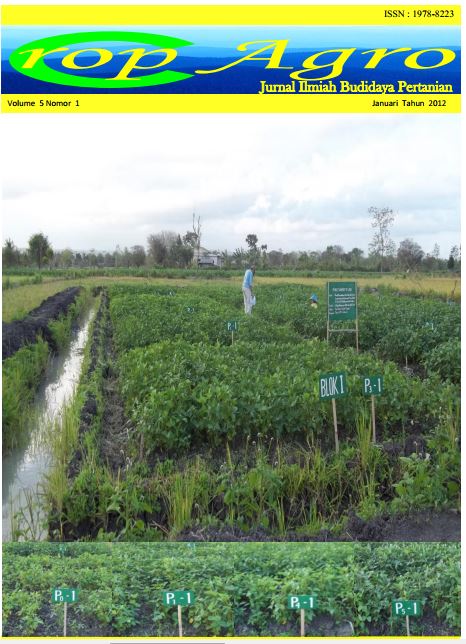PENGARUH BOKASHI PUPUK KANDANG SAPI TERHADAP HASIL TANAMAN PADI (ORYZA SATIVA L.) DENGAN TEKNIK BUDIDAYA KONVENSIONAL DAN S R I YANG DITANAM PADA LAHAN VERTISOL
EFFECT OF COW MANURE BOKASHI ON RICE PADDY (ORYZA SATIVA L.) YIELD GROWN ON VERTISOL WITH CONVENTIONAL AND S R I CULTIVATION TECHNIQUES
Kata Kunci:
kesuburan, berat gabah, panjang malai, gabah hampa, indeks panen, fertility, grain weight, panicle length, empty grains, harvest indexAbstrak
ABSTRAK
Salah satu upaya meningkatkan kesuburan media tumbuh tanaman padi adalah melalui penggunaan pupuk organik antara lain bokashi pupuk kandang sapi. Kelebihan bokashi pupuk kandang sapi adalah dapat memperbaiki srtuktur tanah serta menyediakan hara untuk pertumbuhan dan produksi tanaman padi. Oleh karena itu, telah dilakukan penelitian yang tujuan utamanya untuk mengetahui pengaruh bokashi pupuk kandang sapi terhadap hasil tanaman padi (Oryza sativa L.) dengan teknik budidaya konvensional dan S R I yang ditanam pada lahan vertisol. Penelitian ini menggunakan metode eksperimental dengan melakukan percobaan di Lapangan, yang dirancang menurut Rancangan Acak Kelompok (RAK) yang ditata secara faktorial, dengan dua faktor. Faktor pertama yaitu teknik budidaya (T) dan faktor kedua pemberian bokashi pupuk kandang sapi (B). Hasil penelitian menunjukkan: bahwa perlakuan teknik budidaya berpengaruh terhadap panjang malai, berat kering jerami, bobot 100 butir gabah, dan indeks panen. Teknik budidaya konvensional (T1) memberikan hasil tertinggi pada bobot 100 butir gabah (2,88 g), dan indeks panen (38,75 %). Teknik budidaya SRI (T2) memberikan hasil tertinggi pada panjang malai (22,58 cm) dan berat kering jerami (55,23 g/rumpun); Perlakuan bokashi pupuk kandang sapi hanya berpengaruh terhadap jumlah gabah hampa. Jumlah gabah hampa terendah ditunjukkan oleh perlakuan pemberian pupuk bokashi sebanyak 10 ton/ha (300,66 butir); (3) Tidak ada interaksi nyata antara faktor teknik budidaya dan pemberian bokashi pupuk kandang sapi.
ABSTRACT
One of the efforts to improve Vertisol fertility for rice was through organic fertilizer applications. The organic fertilizer was able to improve the soil and provide nutrients for growth and production of rice plants. Therefore, a study was conducted to determine the effect of Bokashi-cow manure on yields of rice (Oryza sativa L. ) grown with conventional cultivation and SRI growing technique on Vertisol. A Randomized Block Design (RBD) with two factors was used to arrange all of the treatments. The first factor was growing techniques (T) and the second factor was Bokashi-cow manure (B). The results show that the cultivation technique affected panicle length, straw dry weight, weight of 100 grains, and harvest index. Conventional cultivation techniques gave the highest yield in the weight of 100 grains (2.88 g), and harvest index (38.75 %). SRI cultivation technique gave the highest yield on panicle length (22.58 cm) and straw dry weight (55.23 g/clump). In addition, Bokashi-cow manure affected only the empty grains number. The lowest number of empty grains indicated by treatment with an application of 10 ton/ha of cow manure Bokashi (300.66 grains). There is no real interaction between cultivation techniques and Bokashi cow manure.

